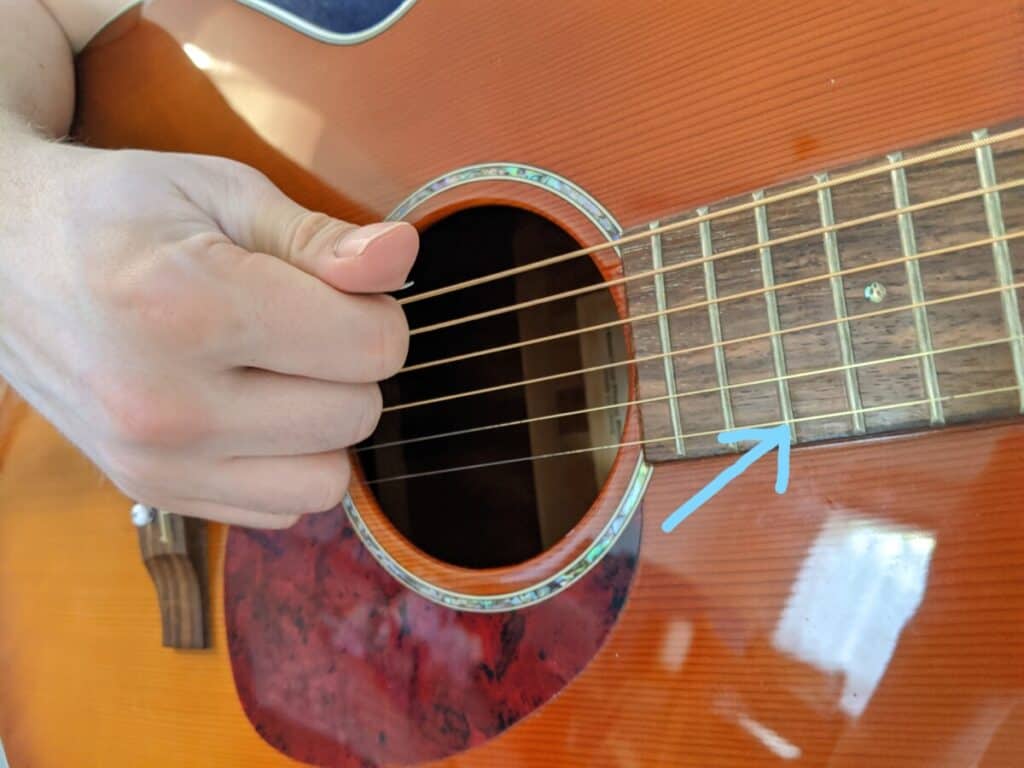This post contains affiliate links. We earn commissions if you purchase products from retailers after clicking on a link from our site. As an Amazon Associate, we earn from qualifying purchases.
There are several tuning configurations for the guitar, what are their different frequencies?
Note: Note frequencies are general information, but I do want to thank Michigan tech for putting all the frequencies in one table.
I’ll be sharing the Standard Tuning along with its frequencies (this is what most guitar lesson books are written in) and I’ll share several alternate tunings and their frequencies.
Standard Notes and Frequencies For Guitar
This is the standard tuning of a guitar. This is what all the music books are written in and where most beginners start. There’s no limit as to how much or how little you use alternate tunings, but this is where most people start.
| Note | Frequency (Hz) |
|---|---|
| E2 | 82.41 |
| A2 | 110 |
| D3 | 146.83 |
| G3 | 196 |
| B3 | 246.94 |
| E4 | 329.63 |
By the way, looking for recording equipment and musical instruments? Check out Sweetwater.com for microphones, monitors, audio interface or any other recording gear that you could ever need. (Affiliate Link)
By the way, looking for a guitar? Check out GuitarCenter.com for acoustic, electric, or classical guitars as well as all the guitar gear you could ever need. (Affiliate Link)
Drop Tunings
Drop D
| Note | Frequency (Hz) |
|---|---|
| D2 | 73.42 |
| A2 | 110 |
| D3 | 146.83 |
| G3 | 196 |
| B3 | 246.94 |
| E4 | 329.63 |
Drop A
| Note | Frequency (Hz) |
|---|---|
| A1 | 55 |
| A2 | 110 |
| D3 | 146.83 |
| G3 | 196 |
| B3 | 246.94 |
| E4 | 329.63 |
Open Tunings
Open A
| Note | Frequency (Hz) |
|---|---|
| E2 | 82.41 |
| A2 | 110 |
| C#3/Db3 | 138.59 |
| E3 | 164.81 |
| A3 | 220 |
| E4 | 329.63 |
Open B
| Note | Frequency (Hz) |
|---|---|
| B1 | 61.74 |
| F#2/Gb2 | 92.5 |
| B2 | 123.47 |
| F#3/Gb3 | 185 |
| B3 | 246.94 |
| D#4/Eb4 | 311.13 |
Open C
| Note | Frequency (Hz) |
|---|---|
| C2 | 65.41 |
| G2 | 98 |
| C3 | 130.81 |
| G3 | 196 |
| C4 | 261.63 |
| E4 | 329.63 |
Open D (More Common)
| Note | Frequency (Hz) |
|---|---|
| D2 | 73.42 |
| A2 | 110 |
| D3 | 146.83 |
| F#3/Gb3 | 185 |
| A3 | 220 |
| D4 | 293.66 |
Open E
| Note | Frequency (Hz) |
|---|---|
| E2 | 82.41 |
| B2 | 123.47 |
| E3 | 164.81 |
| G#3/Ab3 | 207.65 |
| B3 | 246.94 |
| E4 | 329.63 |
Open F
| Note | Frequency (Hz) |
|---|---|
| C2 | 65.41 |
| F2 | 87.31 |
| C3 | 130.81 |
| F3 | 174.61 |
| A3 | 220 |
| F4 | 349.23 |
Open G
| Note | Frequency (Hz) |
|---|---|
| D2 | 73.42 |
| G2 | 98 |
| D3 | 146.83 |
| G3 | 196 |
| B3 | 246.94 |
| D4 | 293.66 |
Popular Tunings
There are hundreds (Wikipedia) of tuning options for the guitar so there’s no way I could list all the possible options, but I asked around in an online guitar community and found out some popular tunings that guitarists use. It turns out that many enjoy some of the following that I already listed above:
- Drop D
- Open F
- Open G
- Open C
DADGAD
| Note | Frequency (Hz) |
|---|---|
| D2 | 73.42 |
| A2 | 110 |
| D3 | 146.83 |
| G3 | 196 |
| A3 | 220 |
| D4 | 293.66 |
Half-Step Down (Jimi Hendrix Style)
| Note | Frequency (Hz) |
|---|---|
| D#2/Eb2 | 77.78 |
| G#2/Ab2 | 103.83 |
| C#3/Db3 | 138.59 |
| F#3/Gb3 | 185 |
| A#3/Bb3 | 233.08 |
| D#4/Eb4 | 311.13 |
Which String Has The Highest Frequency In Guitar?
E4 has the highest frequency on a guitar with standard tuning.
Which one is meant to be tuned to E4? If you take a look at the picture below you’ll see the blue arrow is pointing to the thinnest string on the guitar–this string is meant to be tuned to E4, which is tuned to 329.63 Hz.

In contrast, E2, the string which is the thickest and is right next to my pick shown in the picture, is 82.41 Hz.
Are Some Tunings Bad For My Guitar? (A Warning About Alternate Tunings)
Now that you have all the frequencies for many of the common guitar tunings, you may want to go try them all out to see which one sounds best.
This is completely fine, but you might want to have your cheap strings on first. The thinnest guitar strings are most susceptible to snapping when tuned too high. If you go too far above the standard tuning for each string, you run the risk of snapping your strings.
It’s also possible to put too much stress on the delicate balance of your guitar’s neck relief (the bow in your guitar neck). Be warned, and be careful.
That being said, most tunings for the high E4 string don’t go above F4 for the reason of not wanting to snap their strings. The lower strings have a bit more slack (and therefore flexibility).
What Pitch Should My Guitar Tuner Be Set To?
It turns out that what we decide to be the frequency for the note C is somewhat arbitrary. There is no (at least not that we’ve discovered) magical connection between a note and its frequency. Over the years, musicologists and musicians have settled on A4 (A in the 4th octave) as 440Hz.
There are of course other options–but to keep things simple and to be on track with most circumstances you’ll be in, 440Hz will work great for you.
Just for fun, though, if you would like to see the frequencies for a guitar tuned to 432 Hz (a common standard used mostly in the past)… here you go!
| Note | Frequency (Hz) |
|---|---|
| E2 | 80.91 |
| A2 | 108 |
| D3 | 144.16 |
| G3 | 192.43 |
| B3 | 242.45 |
| E4 | 323.63 |
